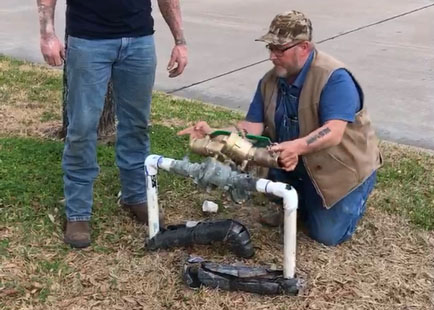What Is Backflow Prevention — and Do I Need It?

Your home’s plumbing system is a modern marvel. Each day, hundreds of gallons of water flow into your home and back out again, supplying it with fresh water and disposing of the wastewater in an efficient and rather discreet fashion. However, while it looks like a fairly simple operation, your home's plumbing system is actually a highly complex arrangement of pipes, pumps, and other fixtures that keep it operating correctly.
There are a hundred ways your plumbing system can malfunction. One of the most common — and most troubling — is called backflow. Backflow can quickly contaminate your clean water supply, not only causing a major hassle, but also posing a health risk to you and your family.
But what is backflow, exactly? And, more importantly, how do you go about preventing it from occurring in the first place?
What Is Backflow?
Backflow refers to a plumbing scenario where water flows in the opposite direction through the plumbing system. When this happens, the clean water line gets contaminated by wastewater flowing in the reverse direction. Basically, pressure disruptions within the plumbing system can cause dirty water to flow into your potable water supply.
In the event of backflow, you’ll likely notice changes in the clean water flowing into your home, including changes in your water’s color, smell and taste. When backflow occurs, pollutants like fertilizers, pesticides and even human waste can make their way into your clean water.
There are two main ways backflow occurs: back pressure or back siphonage. With back pressure, the water pressure from a non-potable water source exceeds the pressure in the water supply line. In other words, the pressure from water flowing downstream becomes greater than the water pressure of the main water source. Elevated tanks, pumps, boilers and other pressurized systems fall prey to back pressure-related backflow.
Back siphonage, on the other hand, is caused by negative pressure in the supply line. When an unexpected loss of pressure occurs in a supply line, water from the waste line is pulled back into the supply line. Any municipal water drainage projects, firefighting emergencies or anything else that significantly increases water demand on the public water supply in a short amount of time can cause backflow to occur.
More Related Articles:
- Calling a Plumber? Here Are the 6 Most Common Plumbing Jobs and How Much They Cost
- 6 Ways to Try to Unclog Your Sink Before You Call a Plumber
- What's in My Plumber's Van?
- Here's How Much It Costs to Remodel a Bathroom
- 6 Tips for Hiring a Plumber
What Is a Backflow Preventer?
Backflow is an alarming situation, to say the least. Fortunately, installing a backflow prevention device in your plumbing system can keep a scenario like this from occurring in the first place. There are several different types of backflow prevention devices, and while each operates differently, they all work to ensure that the water in your plumbing system can only flow in one direction.
Air Gaps
Air gaps are the simplest backflow prevention device. In fact, unlike other prevention devices, an air gap is completely non-mechanical. Instead, an air gap is, essentially, an unobstructed vertical space that prevents clean water and wastewater from mixing together. Generally speaking, air gaps are incorporated into a dishwasher installation. By separating the dirty water line and clean water line, contamination due to backflow is impossible.
Double-Check Valves
While more complex than simplistic air gap devices, the most common type of backflow preventers are double-check valves, or DCVs. These devices use hinged plugs that allow water to flow down the pipe, but prevent it from coming back. Under normal operating conditions, when water pressure is higher on the supply side, the valves remain open, allowing water to flow into the home. But, when the pressure is higher than the input, the valves close, preventing the vacuum effect from occurring.
Atmospheric Vacuum Breaker
Another common type of backflow device is called an atmospheric vacuum breaker, or AVB. These devices prevent backflow from occurring in hoses, faucets, and spigots. When a plumbing system experiences a significant drop in pressure, a vacuum is created that sucks in wastewater from the sewer line. AVBs work by opening an air vent when a loss of pressure is detected. When the air vent is open, it breaks the vacuum, and the supply line is sealed off, preventing backflow from occurring.
Do I Need to Install a Backflow Preventer?
Generally speaking, backflow prevention devices aren’t required by plumbing and building codes in most places. That said, if you receive water from a well or have an irrigation sprinkler system, you may be required to install one, depending on your local municipality. But, even though you may not be required to install a residential backflow preventer, it can be a good idea to put one in. This is due to the fact that backflow often occurs due to outside influences that aren’t under your control, like fire hydrant testing or other water drainage projects.
Elocal Editorial Content is for educational and entertainment purposes only. Editorial Content should not be used as a substitute for advice from a licensed professional in your state reviewing your issue. Systems, equipment, issues and circumstances vary. Follow the manufacturer's safety precautions. The opinions, beliefs and viewpoints expressed by the eLocal Editorial Team and other third-party content providers do not necessarily reflect the opinions, beliefs and viewpoints of eLocal or its affiliate companies. Use of the Blog is subject to the
Website Terms and Conditions.The eLocal Editorial Team operates independently of eLocal USA's marketing and sales decisions.



